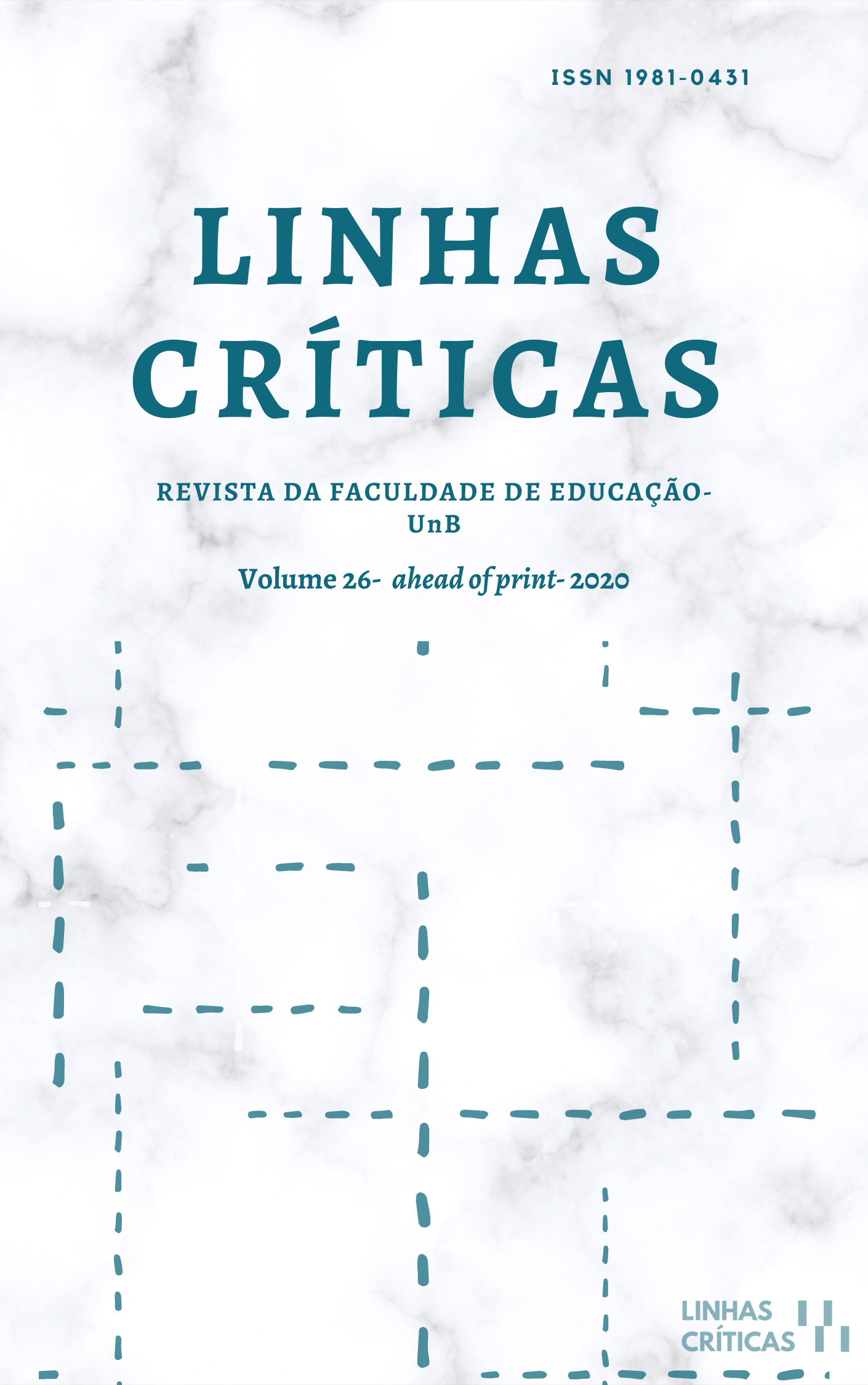Technological rationality and the education of children’s bodies in times of pandemic
DOI:
https://doi.org/10.26512/lc.v26.2020.36330Keywords:
Childhood, Formation of Bodies, School, Technological Rationality, Pandemic CrisisAbstract
This theoretical study aims to examine the impacts of technological rationality on the education of children’s bodies in pandemic times. Part of the recomposition of the schooling process, caused by the health crisis generated by the new coronavirus (SARS-Cov-2), to assess possible repercussions on body formation in the context of remote education. It is based on the contributions of the Critical Theory of Society and, while recognizing the importance of future comparisons with empirical data, it already identifies signs of the persistence of a productive logic, typical of the managed world, since the body continues to be called upon to submit and to sacrifice.
Downloads
References
Adorno, T. W. (1995). Palavras e sinais: modelos críticos 2. Vozes.
Adorno, T. W. (1996). Teoria da semicultura. Educação & Sociedade, 56, 388-411.
Adorno, T. W. (2012). Educação após Auschwitz. Em T. W. Adorno. Educação e Emancipação (pp. 119-138). Paz e Terra.
Benjamin, W. (1994). Experiência e pobreza. Em W. Benjamin. Magia e técnica, arte e política: ensaios sobre literatura e história da cultura (pp. 114-119). Brasiliense.
Benjamin, W. (1995). Infância em Berlim por volta de 1900. Em W. Benjamin. Rua de mão única (pp. 9-70). Brasiliense.
Buss-Simão, M., & Lessa, J. S. (2020). Um olhar para o(s) corpo(s) das crianças em tempos de pandemia. Zero-a-seis, 22(esp), 1420-1445. https://doi.org/10.5007/1980-4512.2020v22nespp1420
Campanha Nacional pelo Direito à Educação. (2020). Guia COVID-19. Educação a distância. https://media.campanha.org.br/acervo/documentos/COVID-19_Guia3-EaD_FINAL.pdf
Castells, M. (2007). A sociedade em rede. Paz & Terra.
Castro, C. S., & Zuin, A. A. S. (2018). Indústria cultural e distração concentrada: as plataformas digitais e o ensino personalizado. Comunicações, 25(2), 79-94. https://doi.org/10.15600/2238-121X/comunicacoes.v25n2p79-94
Crochík, J. L. (2003). Teoria Crítica e novas tecnologias da educação. Em B. Pucci, L. A. C. N. Lastória, & B. C. G. Costa. (orgs.). Tecnologia, Cultura e Formação… ainda Auschwitz (pp. 97-114). Cortez.
Crochík, J. L. (2014). As relações entre os docentes e as tecnologias de informação e comunicação nas atividades de ensino e pesquisa. CONSTELACIONES – Revista de Teoria Crítica, 6, 414-425. http://constelaciones-rtc.net/article/view/880/930
Dussel, I. (2020). La escuela en la pandemia. Reflexiones sobre lo escolar en tiempos dislocados. Práxis Educativa, 15. https://doi.org/10.5212/PraxEduc.v.15.16482.090
Feenberg, A. (1991). Critical theory of technology. Oxford University Press.
Freud, S. (1997). O mal-estar na civilização. Imago.
Horkheimer, M. & Adorno, T. W. (1985). Dialética do Esclarecimento: fragmentos filosóficos. Jorge Zahar.
Horkheimer, M. (2000). A revolta da natureza. Em M. Horkheimer. Eclipse da razão (pp. 97-130). Centauro.
Lévy, P. (1999). Cibercultura. Editora 34.
Marcuse, H. (1999). Algumas implicações sociais da tecnologia moderna. Em H. Marcuse. Tecnologia, guerra e fascismo (pp. 71-104). Unesp.
Morgado, J. C., Sousa J., & Pacheco, J. A. (2020). Transformações educativas em tempos de pandemia: do confinamento social ao isolamento curricular. Práxis educativa, 15. https://doi.org/10.5212/PraxEduc.v.15.16197.062
Núcleo Ciência Pela Infância [NCPI]. (2020). Repercussões da pandemia de COVID-19 no desenvolvimento infantil. Fundação Maria Cecilia Souto Vidigal. https://ncpi.org.br/wp-content/uploads/2020/05/Working-Paper-Repercussoes-da-pandemia-no-desenvolvimento-infantil-3.pdf
Ramos da Rocha, D., & Moreira Hypolito, Á. L. (2020). Disputas pela escola pública: contribuições históricas para pensar o trabalho docente. Linhas Críticas, 26, e31908. https://doi.org/10.26512/lc.v26.2020.31908
Selwyn, N. (2017). Educação e Tecnologia: questões críticas. Em G. M. S. Ferreira, L. A. S. Rosado, & J. S. Carvalho. (orgs). Educação e Tecnologia: abordagens críticas (pp. 85-104). SESES. https://ticpe.files.wordpress.com/2017/04/ebook-ticpe-2017.pdf
Sociedade Brasileira de Pediatria [SBP]. (2020a). Nota de Alerta - Recomendações sobre o uso saudável das telas digitais em tempos de pandemia da COVID-19. https://www.sbp.com.br/fileadmin/user_upload/22521b-NA_Recom_UsoSaudavel_TelasDigit_COVID19__BoasTelas__MaisSaude.pdf
Sociedade Brasileira de Pediatria [SBP]. (2020b). Manual de orientação – Grupo de trabalho Saúde na Era Digital: Dependência virtual – um problema crescente. https://www.sbp.com.br/fileadmin/user_upload/22496c-MO_-_DepVirtual__MenosVideos__MaisSaude.pdf
Türcke, C. (2010). Sociedade excitada: Filosofia da sensação. Unicamp.
Zuin, V. G., & Zuin, A. A. S. (2018). A indústria cultural algorítmica na era da Internet das Coisas. Educação e Filosofia, 32(66), 1131-1156. https://doi.org/10.14393/REVEDFIL.issn.0102-6801.v32n66a2018-07
Published
How to Cite
Issue
Section
License
Copyright (c) 2021 Luciane Paiva Alves de Oliveira

This work is licensed under a Creative Commons Attribution 4.0 International License.
Authors who publish in this journal agree to the following terms:
-Authors maintains the copyright and grants the journal the right of first publication, the work being simultaneously licensed under the Creative Commons Attribution License which allows the sharing of the work with recognition of the authorship of the work and initial publication in this journal.
- Authors are authorized to enter into additional contracts separately, for non-exclusive distribution of the version of the work published in this journal (eg publish in institutional repository or as a book chapter), with acknowledgment of authorship and initial publication in this journal.
-Authorers are allowed and encouraged to publish and distribute their work online (eg in institutional repositories or on their personal page) at any point before or during the editorial process, as this can generate productive changes as well as increase the impact and the citation of published work (See The Effect of Free Access).



